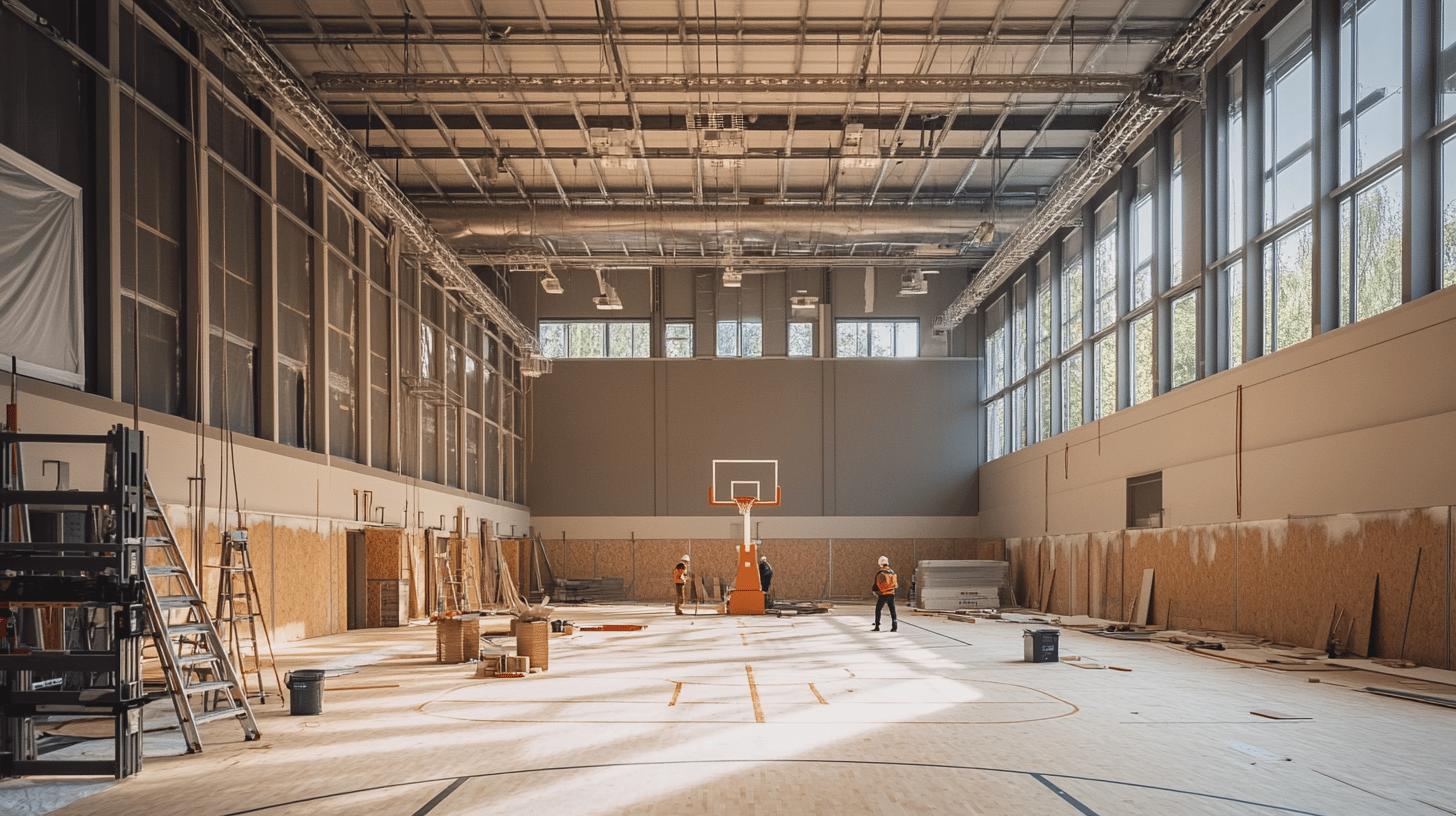Is the thought of a costly sports-hall overhaul making you reconsider your plans? Fear not; flexible finance options offer the perfect solution. From leasing and loans to grants and sponsorships, a variety of financing avenues are available that can transform your sporting venue without breaking the bank. Tailored payment schedules and strategic partnerships not only alleviate financial pressures but also maximise the potential of your facility. Dive into our detailed guide to discover how these options can make your sports-hall renovation a reality while ensuring long-term success.
Exploring Flexible Finance Options for Sports-Hall Overhauls
Flexible financing is crucial for sports-hall overhauls, enabling facilities to undertake comprehensive renovations without straining their budgets. These financial solutions cater to varying scales and timelines, ensuring that projects remain feasible and financially sustainable. By leveraging options such as leasing, loans, and grants, sports facilities can align their financial strategies with renovation needs. This approach allows facilities to manage cash flow effectively, address immediate needs, and plan for long-term growth. Flexible finance options not only ease financial pressures but also open avenues for modernising sports infrastructure, enhancing community engagement, and promoting sports participation.
- Leasing: Offers the advantage of spreading costs over time with lower initial payments, making it accessible for facilities with limited immediate capital.
- Loans: Provide a lump sum upfront, allowing for substantial renovations with varying interest rates and repayment terms tailored to the project’s scale.
- Grants: Available from government and private bodies, often competitive and criteria-specific, providing non-repayable funds for qualifying projects.
- Strategic Partnerships: Involve collaborations with local businesses, sharing resources and costs, which can lead to mutually beneficial outcomes.
- Sponsorships: Engage businesses and brands in funding exchanges for marketing opportunities, enhancing visibility and community involvement.
.
Each finance option presents distinct benefits and challenges. Leasing reduces upfront expenditure but may lead to higher long-term costs. Loans offer significant funding but require careful interest and repayment management. Grants provide non-repayable funding but demand rigorous application processes and adherence to specific criteria. Strategic partnerships and sponsorships can inject additional resources and foster community ties, though they necessitate strong proposals demonstrating mutual benefits. By understanding these options, sports facilities can strategically select the most suitable financial pathways for their renovation needs, ensuring successful project execution and sustainable financial health.
Lease-Purchase and Phased Install Finance for Sports Facilities
Lease-purchase agreements offer a compelling solution for sports facilities aiming to acquire new equipment or renovate existing structures without immediate full payment. These agreements allow facilities to lease equipment or project components with the option to purchase them at the end of the lease term. This approach provides flexibility in budgeting and planning, as it spreads costs over time while eventually leading to ownership. The reduction in initial financial burden enables facilities to allocate resources to other critical areas, making lease-purchase agreements an attractive option for those with limited upfront capital.
Phased install finance is another flexible payment plan that caters specifically to large-scale projects requiring gradual implementation. By breaking down the project into manageable phases, facilities can align financial outlays with their cash flow capabilities. This method supports project scalability, allowing facilities to adjust the pace and scale of renovations based on available funds. It also offers better financial management as payments are distributed over the project’s timeline, reducing the pressure of large upfront expenses. Phased installs ensure that facilities can maintain operational stability while progressively enhancing their infrastructure.
Strategically employing lease-purchase agreements and phased install finance options can significantly benefit sports facilities. These methods not only provide financial flexibility but also enable facilities to pursue comprehensive upgrades without compromising their financial health. By integrating these finance options, sports facilities can enhance their capabilities, improve user experiences, and maintain a competitive edge in the sports community.
Securing Loans for Comprehensive Sports-Hall Renovations

Structuring loans effectively is pivotal for sports-hall renovations, especially for large-scale projects. Loans provide a substantial upfront sum, enabling immediate project commencement. The flexibility in loan structuring allows facilities to align interest rates and repayment terms with their specific financial situations and project timelines. This adaptability ensures that the financial burden remains manageable, facilitating renovations without jeopardising the facility’s financial health. Financial institutions that specialise in sports facility financing often offer tailored loan products, with competitive rates designed to meet the unique needs of sports-hall projects.
| Loan Type | Interest Rate | Repayment Term |
|---|---|---|
| Fixed-Rate Loan | 3-5% | 10-15 years |
| Variable-Rate Loan | 2.5-4.5% | 5-10 years |
| Balloon Loan | 4-6% | 15-20 years |
Selecting the right loan provider is as important as choosing the loan type itself. Providers specialising in sports facility financing are likely to offer more customised terms and conditions, understanding the unique challenges and opportunities within this sector. Evaluating the lender’s experience, interest rates, and repayment flexibility is essential. Additionally, facilities should seek lenders who demonstrate a commitment to supporting sports infrastructure, providing not only funds but also advice and expertise tailored to the renovation needs of sports halls.
Navigating Grant Opportunities for Sports-Hall Overhauls
Identifying grant opportunities for sports-hall overhauls begins with understanding the sources available. Government bodies at both national and local levels frequently offer grants aimed at improving sports infrastructure, often prioritising projects that benefit under-represented communities or areas with high social deprivation. Charitable foundations also play a significant role, providing sports facility grants that align with their mission to enhance community wellbeing through sports. To locate these opportunities, facilities should regularly monitor government announcements and maintain relationships with organisations that provide philanthropic support for sports development.
The application process for sports facility grants is typically competitive and requires detailed preparation. Applicants must align their projects with the grant’s specific criteria, which can include demonstrating community impact, sustainability, and financial viability. It’s crucial to craft a comprehensive proposal that outlines the project’s objectives, expected outcomes, and how it aligns with the funder’s goals. Additionally, grant applications often necessitate supporting documents such as financial projections, architectural plans, and letters of support from community stakeholders. Understanding these requirements and preparing accordingly increases the likelihood of securing funding.
Examples of Successful Grant Applications
Successful grant-funded sports-hall projects have significantly benefited communities. For instance, initiatives supported by the Football Foundation have resulted in enhanced facilities that promote increased sports participation and community engagement. Similarly, Sport England grants have facilitated upgrades that improve accessibility and inclusivity in sports venues. These projects not only enhance the quality of sports facilities but also foster a sense of community pride and contribute to the overall health and wellbeing of local populations. By learning from these examples, sports facilities can strategically target grants that align with their renovation goals and community needs.
Strategic Partnerships and Sponsorships in Sports Facility Financing
Strategic partnerships and sponsorships present viable avenues for funding sports-hall overhauls. By aligning with local businesses and securing sponsorships, sports facilities can tap into additional financial resources beyond traditional funding methods. These collaborative funding models not only provide necessary capital but also foster community ties and enhance the facility’s visibility. Establishing such partnerships often hinges on demonstrating the mutual benefits involved, such as increased market reach for sponsors or enhanced community engagement for local businesses. A compelling business plan that outlines the revenue potential and community impact of the sports-hall project is crucial in attracting the right partners.
- Increased funding: Partnerships and sponsorships can significantly boost financial resources available for renovations.
- Community engagement: Collaborations can strengthen community ties by involving local businesses and stakeholders.
- Shared resources: Partners may offer not just financial support but also services or equipment, reducing overall project costs.
- Marketing opportunities: Sponsors gain exposure through branding and advertising, enhancing their public profile while supporting community initiatives.
.
Crafting effective proposals to attract partners requires a strategic approach. Highlighting the benefits to potential sponsors or partners is essential. This includes demonstrating how their involvement will increase brand visibility and contribute positively to community development. Providing detailed projections on how the partnership will enhance the facility’s usage and revenue potential can also be persuasive. Additionally, showcasing past successful collaborations or partnerships can build credibility and assure potential partners of the project’s viability. By tailoring proposals to align with the goals and values of prospective partners, sports facilities can forge successful partnerships that facilitate comprehensive overhauls.
Financial Planning and Risk Management for Sports-Hall Overhauls

Effective financial planning is the backbone of successful sports-hall overhauls. Establishing a solid budget is essential to cover both installation and ongoing maintenance costs. This budget should not only address immediate financial needs but also assess the long-term financial viability of the project. Detailed financial assessments allow facilities to identify potential cost overruns and allocate resources efficiently. By projecting future expenses and revenues, sports facilities can make informed decisions that align with their strategic goals and ensure that renovations are completed without compromising financial stability.
- Diversify funding sources to mitigate reliance on a single financial stream.
- Maintain a contingency fund to address unexpected expenses or financial shortfalls.
- Implement regular financial reviews to adjust plans based on current economic conditions.
- Consider insurance options to protect against unforeseen risks and liabilities.
- Develop a phased project approach to manage costs and align spending with available funds.
.
Implementing these risk management strategies is crucial to sustaining projects financially. Diversifying funding sources reduces vulnerability to potential financial disruptions. A contingency fund acts as a safety net, allowing projects to continue even when unexpected costs arise. Regular financial reviews enable facilities to adapt to changes in the economic landscape, ensuring that their financial plans remain relevant and effective. Insurance provides an additional layer of protection against unforeseen risks, while a phased project approach allows for a manageable and scalable renovation process. By integrating these strategies, sports facilities can navigate financial challenges and achieve successful overhauls.
Final Words
Exploring flexible finance options for complete sports-hall overhauls highlights the importance of strategic financial planning in transforming sports facilities.
Options such as leasing, loans, grants, partnerships, and sponsorships each offer unique benefits and challenges.
Engaging with these financial avenues can enhance facility safety, prolong lifespan, and maintain aesthetic appeal.
With careful planning and implementation, these solutions provide the flexibility needed for a comprehensive sports-hall overhaul.
By leveraging these flexible finance options, facilities can deliver an optimal sports experience, benefiting both the community and stakeholders.
Discuss finance → Sports Flooring Contractors
FAQ
What funding options are available for sports projects and facilities?
Government funding, grants from organisations like the National Lottery, and sport-specific bodies such as Sport England offer support for various sports projects. These include sports-equipment grants and funds for infrastructure like astroturf installations.
How can individuals access sport funding grants?
Individuals seeking sport funding grants should identify relevant programmes from government bodies and sports organisations. Each programme has unique eligibility criteria and application processes, often requiring detailed proposals showcasing project benefits.
What financial support is available for sports-hall renovations?
Flexible finance options such as leasing, loans, grants, strategic partnerships, and sponsorships facilitate sports-hall overhauls. Each option offers distinct advantages like spreading costs, immediate funding, or leveraging community partnerships.
How do lease-purchase agreements work for sports facilities?
Lease-purchase agreements allow sports facilities to use equipment or spaces while gradually paying towards ownership. This option lowers upfront costs and aligns financial planning with long-term budgeting strategies.
What is the advantage of phased install finance?
Phased install finance allows sports projects to be completed incrementally, offering scalability and manageable payments. This flexibility facilitates financial management and aligns with cash flow while ensuring project continuity.
How are loans structured for sports-hall renovations?
Loans provide a lump sum with tailored interest rates and repayment terms based on project scale and timeline. Engaging financial institutions that specialise in sports facility financing can secure competitive loan terms.
What are the key considerations in applying for sports facility grants?
Applications for sports facility grants must meet specific criteria, such as targeting under-represented groups. A competitive application process often includes detailed proposals demonstrating community benefits and long-term sustainability.
How can strategic partnerships enhance sports facility financing?
Strategic partnerships with local businesses offer additional funding avenues through shared resources and marketing opportunities. Creating compelling proposals that highlight revenue potential and community impact is key to attracting partners.


